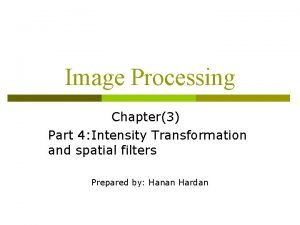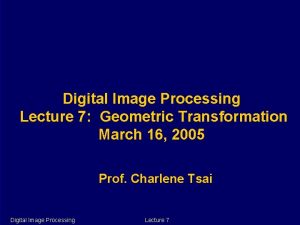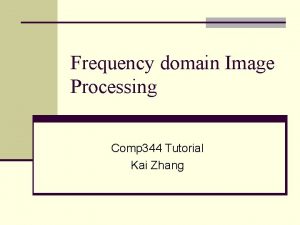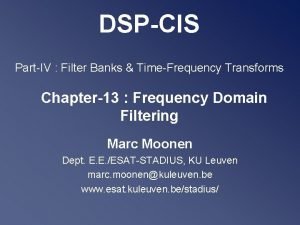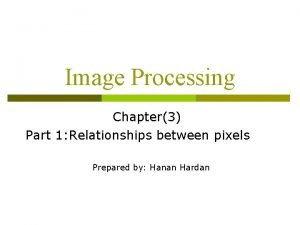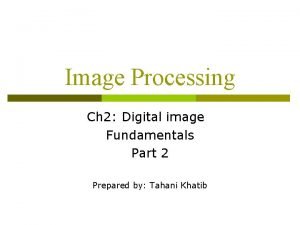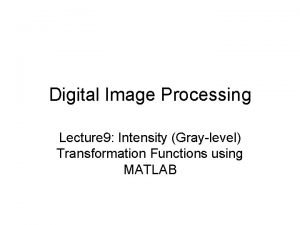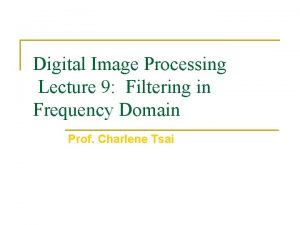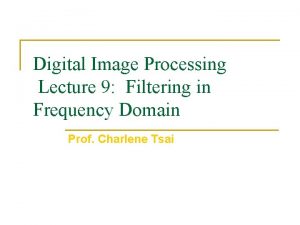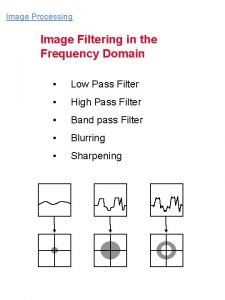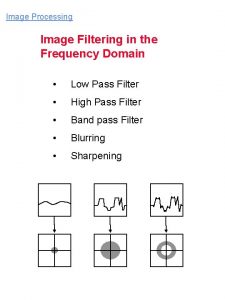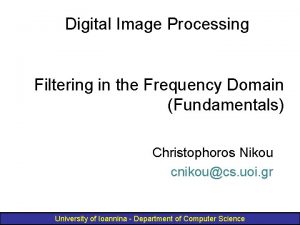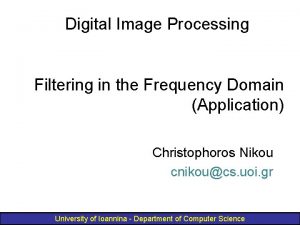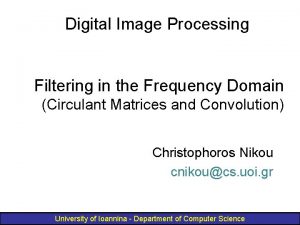Lecture 6 Digital Image Processing Frequency Filtering 1


































- Slides: 34

Lecture #6 Digital Image Processing Frequency Filtering 1 st Semester 2019 -2020 Dr. Abdulhussein Mohsin Abdullah Computer Science Dept. , CS & IT College, Basrah Univ.

Fourier Series & The Fourier Transform • Fourier Series Any periodic function can be expressed as the sum of sines and /or cosines of different frequencies, each multiplied by a different coefficients • Fourier Transform Any function that is not periodic can be expressed as the integral of sines and /or cosines multiplied by a weighing function Joseph Fourier 1768 -1830

Periodic Functions A function is periodic if it is defined for all real and if there is some positive number, such that

Fourier Series be a periodic function with period The function can be represented by a trigonometric series as: What kind of trigonometric (series) functions are we talking about?



A plane wave with a single frequency

Adding a second plane wave at a different frequency results in an intensity modulation as a function of time.





Time and Frequency • example : g(t) = sin(2 pi f t) + (1/3)sin(2 pi (3 f) t)

Time and Frequency • example : g(t) = sin(2 pi f t) + (1/3)sin(2 pi (3 f) t) = +

Frequency Spectra • example : g(t) = sin(2 pi f t) + (1/3)sin(2 pi (3 f) t) = +


What happens when the function is not periodic? When you add a discrete amount of harmonic waves, the resulting function always repeats at the fundamental (lowest) frequency in the series: So how do you find the spectrum for the more general case of a nonperiodic function that exists from -∞ to ∞? Answer: replace the discrete sum by an integral over a continuous range of frequencies: Note that m is integer, while ω can have any (real) value

The Fourier Transform f(x) Fourier Transform F(w) Inverse Fourier Transform f(x) These transformations allow you to calculate the frequency dependence F(ω) of a time domain function f(t), and vice versa. There are different definitions of these transforms. The 2π can occur in several places, but the idea is generally the same.

Frequency Filtering: Main Steps 1. Take the FT of f(x): 2. Remove undesired frequencies: 3. Convert back to a signal:

Example: Removing undesirable frequencies noisy signal remove high frequencies reconstructed signal

2 D Fourier transform

How do frequencies show up in an image? • Low frequencies correspond to slowly varying pixel intensities (e. g. , continuous surface). • High frequencies correspond to quickly varying pixel intensities (e. g. , edges) Original Image Low-passed



1 D FT

1 D FT


Why do we transform images? Ø Images can be analyzed in different kinds of spaces Ø The purpose is not to complicate the information but change the way we view the information • For example, two can be represented as 1+1, 2 cos(0), 2 sin(pi/2), 2*1, sqrt(4) Ø There are various types of transformations • Discrete Cosine Transform, Fourier Transform, Discrete Wavelet transform, and etc.

q The equation for a 2 -D Fourier Transform is: q The Inverse Fourier Transform

How to interpret Fourier Space? • The Fourier Spectra shows both low and high frequency components Ø Low frequencies are near the origin Ø High frequencies are away from the origin

Centered spectra • It is useful to visualize a centered spectrum with the origin of the coordinate system (0, 0) in the middle of the spectrum. • Assume the original spectrum is divided into four quadrants. The small gray-filled squares in the corners represent positions of low frequencies. • Due to the symmetries of the spectrum the quadrant positions can be swapped diagonally and the low frequencies locations appear in the middle of the image.

Filtering in frequency domain Ø Filtration in the frequency domain. Conversion to the ‘frequency domain’, filtration there, and the conversion back.

n m v u

|F(u, v)| f(m, n) 0 u m 0 n 0 v 0
 In digital image processing
In digital image processing Intensity transformations and spatial filtering
Intensity transformations and spatial filtering Histogram processing in digital image processing
Histogram processing in digital image processing Unsharp masking matlab
Unsharp masking matlab Neighborhood processing in digital image processing
Neighborhood processing in digital image processing Point processing in image processing
Point processing in image processing Image enhancement by point processing
Image enhancement by point processing Morphological processing in digital image processing
Morphological processing in digital image processing Linear filtering in image processing
Linear filtering in image processing Ingress filtering vs egress filtering
Ingress filtering vs egress filtering Translate
Translate Optimum notch filter in digital image processing
Optimum notch filter in digital image processing Compression in digital image processing
Compression in digital image processing Key stages in digital image processing
Key stages in digital image processing Objective fidelity criteria
Objective fidelity criteria Image sharpening and restoration
Image sharpening and restoration Geometric transformation in digital image processing
Geometric transformation in digital image processing Zooming and shrinking in digital image processing
Zooming and shrinking in digital image processing Digital image processing
Digital image processing Maketform matlab
Maketform matlab Noise
Noise Image processing lecture notes
Image processing lecture notes Euclidean transformation in digital image processing
Euclidean transformation in digital image processing Image processing frequency domain
Image processing frequency domain Frequency filtering
Frequency filtering Frequency filtering
Frequency filtering Frequency filtering
Frequency filtering Explain various boundary descriptors.
Explain various boundary descriptors. Representation and description in digital image processing
Representation and description in digital image processing Double thresholding in image processing
Double thresholding in image processing Oerdigital
Oerdigital Basic relation between pixels
Basic relation between pixels What are intensity transformations?
What are intensity transformations? For coordinates p(2,3) the 4 neighbors of pixel p are
For coordinates p(2,3) the 4 neighbors of pixel p are Gray level transformation in digital image processing
Gray level transformation in digital image processing

